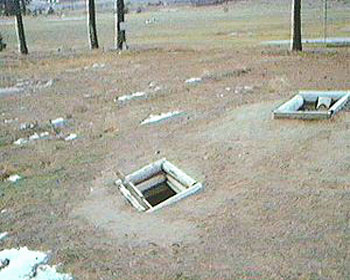Quiggly
Holes
Learning about ancient cultures can be a fascinating
experience. It is always amazing to see how people used
to live in different parts of the world. While there are
many interesting parts of their culture to learn about,
discovering the type of homes they lived in not only gives
clues about what they were like, but what lessons can
be taken from them and applied to life today.

Quiggly Holes |
|
The First Nations, the native people of British Columbia,
are an interesting group of individuals to learn about.
This particular people group lived in homes known as quiggly
holes (or kekuli). A quiggly hole, or quiggly for short,
is what's known as an "earth lodge."
Under Where?
The term "quiggly" means "under",
which gives us a clue about where these kind of homes
were located. When you spot a quiggly, it appears as a
depression in the ground that is circular in shape. Most
of these homes were built in small communities known as
"quiggly towns."
The size of these towns or villages number from a few
hundred to possibly thousands. Many of the holes were
located in areas that were close to water and game, which
the people needed for food. Some of the houses were designed
for a single person or family, while others were designed
to house larger groups and families. There are so many
of these holes in certain parts of British Columbia that
they have become a part of the local landscape.
Root of the Issue …
The idea of the quiggly hole comes from the root cellar.
There were many different uses for this type of construction
besides housing. Some individuals used the holes for storing
extra supplies, while some used them as makeshift kitchens.
The design for these homes was relatively simple.

Quiggly Hole
When someone needed to make one of these holes, they
would dig a very deep pit in the ground, and then create
a roof constructed from logs. The roof was dome shaped.
They usually contained a fire hole to allow the smoke
from a fire to escape out into the air. Most often, people
of the First Nations would enter and exit the hole via
a ladder, or they would create a second doorway out the
side of the dwelling.
When most people refer to quiggly holes, it is in reference
to those that have long since been abandoned, rather than
active housing units today. This is a popular reference
for stories being told, or archaeologists who are speaking
of events from the past. There are some First Nation communities
that still use these types of homes, but have improved
on their design.
Just Say No …
If you desire to see what these historic homes looked
like, then you might want to consider visiting the Fort
Chilcotin site, which is full of quiggly holes. A small
number of individuals go there to dig for arrowheads,
which is frowned upon, as it could destroy the historical
artifacts and records that exist in the area.
Otherwise, Feeling Quiggly yet?

You May Also Like ...
By the way, in the United States the quiggly holes are
called earth lodges
|